Just last week we broke the news that OWC had migrated to Toshiba toggle NAND in their high-end Mercury Extreme Pro 6G SSD family. Not just that, but the 240GB and 480GB capacities took home a processor upgrade too, moving from a SandForce SF-2281 to an SF-2282. We’ve spent the last week working over the ME Pro 6G Redux to see just how much the new NAND and processor help out.
From a hardware perspective, this move puts the OWC drives on NAND parity with the OCZ Vertex 3 Max IOPS and Patriot Wildfire SSDs. With synchronous NAND in the first-generation Mercury Extreme Pro 6G, competitors included the standard OCZ Vertex 3. In the case of the larger capacities, the processor upgrade actually makes these drives one of a kind, at least for now. The challenge in the enthusiast SSD space though is making a name for yourself – finding that one thing or collection of things to separate yourself from the slew of other SSD providers.
OWC has quite a few things going for them; drives are assembled in the US, they offer a best in class warranty of five years and use top quality components. Now they have even better components, from a performance perspective at least. We’ll see how much those help as we break down the 120GB and 240GB Mercury Extreme Pro 6G SSDs with the new toggle NAND in this review.
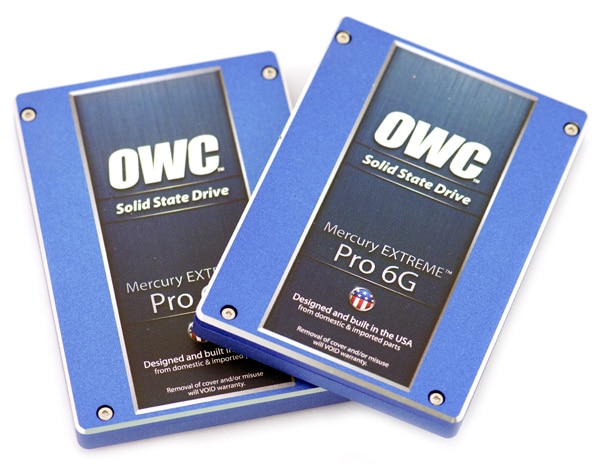
OWC Mercury Extreme Pro 6G SSD Specifications:
- SandForce SF-2282 Processor inside 240GB model, SF-2281 in 120GB
- Toggle DDR NAND
- SATA 6Gb/s
- Sustained Sequential Read – up to 559MB/s, Write – up to 527MB/s
- I/O Per Second (IOPS): Random 4KB – up to 60,000 IOPS
- ECC Recovery: Up to 55 bytes correctable per 512-byte sector
- Non-recoverable Read Errors: Less than 1 sector per 1016 bits read
- Chip Based Data Encryption: 256-bit & 128-bit AES-compliant
- TRIM Support
- Power Consumption: Active – <3W, Idle – <1.2W
- Warranty – 5 Years
Aesthetics
OWC stays true to their Mercury Extreme Pro roots with the design of the 6G SSD. The body is an all-metal design, painted metallic blue, with a machined edge circling the top of the drive. The model sticker on top of the drive has been updated from past models; now a full-gloss sticker with the OWC brand prominently displayed with the Mercury Extreme Pro 6G name. OWC also makes sure to use the label to point out their drives are designed and built in the USA, which is pretty rare these days in the tech market.
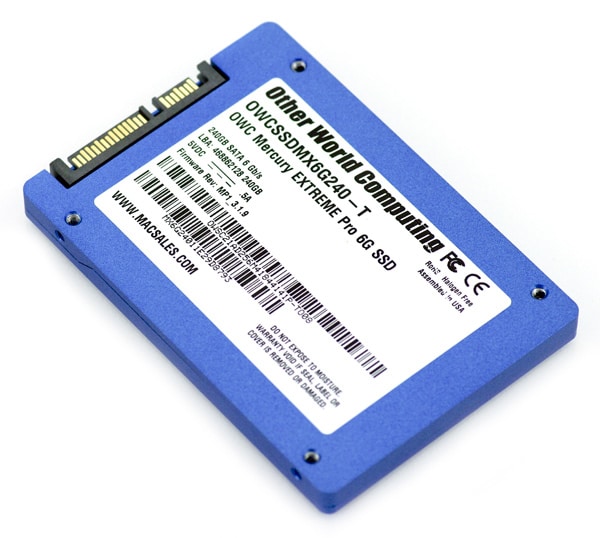
The bottom of the drive is more down to earth, with the detailed information about the drive listed, including the serial number, model number, firmware revision, and drive size specifics. The ME Pro 6G also includes lower mounting holes, which are part of the 2.5-inch drive standard.

The sides are standard, with the case seam and ground top-cover border both visible. The cut top edge looks pretty cool, reflecting light and color depending on what angle you look at the drive from.
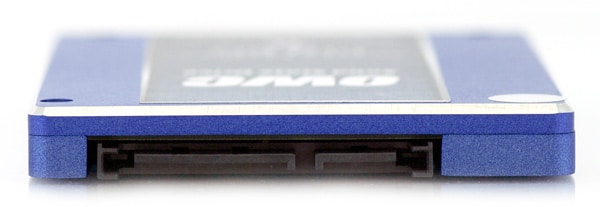
On the front the OWC ME Pro 6G has the SATA power and data connection, with no service pins visible. Overall the look and feel of the new 6G is very impressive. Not that looks matter a great deal when it comes to selecting an SSD, but there’s something to be said for a case design that’s sturdy and visually appealing.
Disassembly
Before I go into the steps on taking apart the Mercury Extreme Pro 6G, popping the drive open will void the warranty. Both of our review models included “Warranty Void if Removed” stickers covering one of the case screws, which are tamper-evident. If you want to keep the industry-leading five-year warranty don’t open up the case.
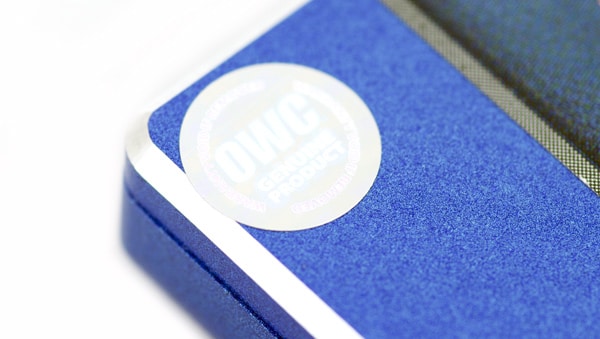
Taking the OWC ME Pro 6G apart is very simple by removing four Allen screws from the top of the drive. With the four screws removed the top cover easily lifts off, exposing the bottom of the circuit board. One of the first things we noticed–besides the NAND swap–was the circuit board got an update. The original ME Pro 6G had a wire soldered on bridging a few leads, while this time the wire is no longer present.
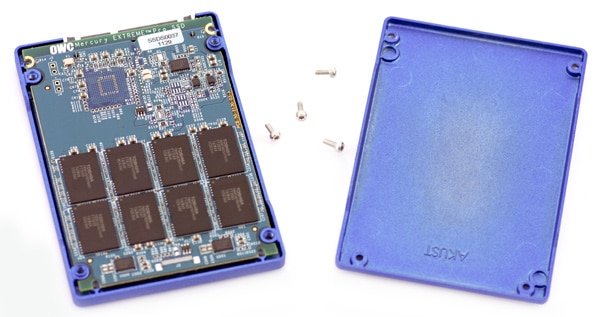
OWC opted for the 16-byte lane SandForce SF-2282 controller in the updated 240GB ME Pro 6G over the 8-byte lane in the older, as well as the 120GB, ME Pro 6G. The primary difference between both of these models is the 16-byte version supports higher capacities (although the SF-2281 does support 240GB SSDs). Both models offer the same type of flash; Toshiba toggle-mode NAND.
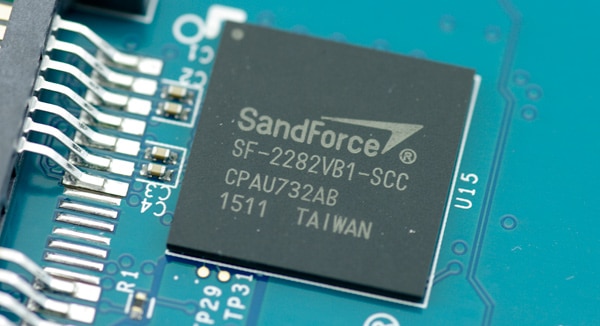
Depending on the capacity of the SSD, the ME Pro 6G is equipped with either eight or sixteen NAND pieces. Similar to the 120GB Patriot Inferno, the 120GB ME Pro 6G has only one side of the circuit board populated with memory, while the larger 240GB model completely fills both sides. Both models make use of 16GB Toshiba TH58TAG7D2FBA89 chips.
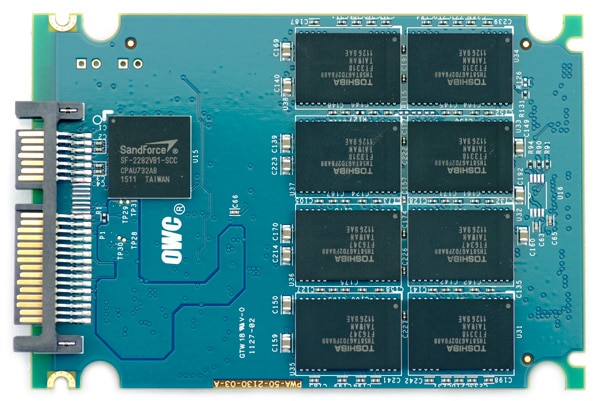
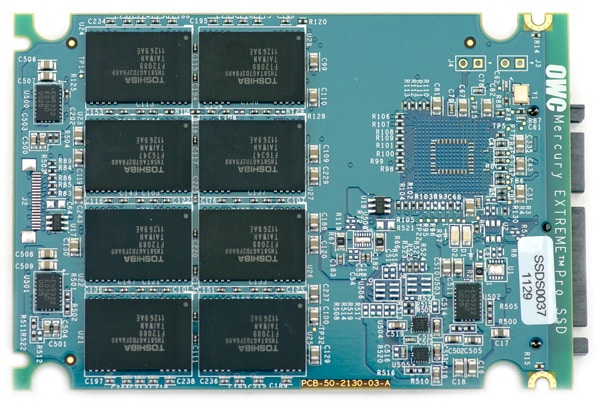
Synthetic Benchmarks
We put the 120GB and 240GB OWC Mercury Extreme Pro SSDs up against the 240GB OCZ Vertex 3 and 120GB Patriot Inferno, as they all offer Toshiba toggle NAND in eight or sixteen NAND piece configurations. This means that outside of firmware differences, they are as close as possible in hardware.
To gauge a drive’s straight line performance, we start with a sequential 2MB transfer test in IOMeter, measuring speeds with both repeating data and incompressible random data. For SandForce-equipped SSDs this shows a best and worst case range of speeds, which real-world usage fall in somewhere in-between.
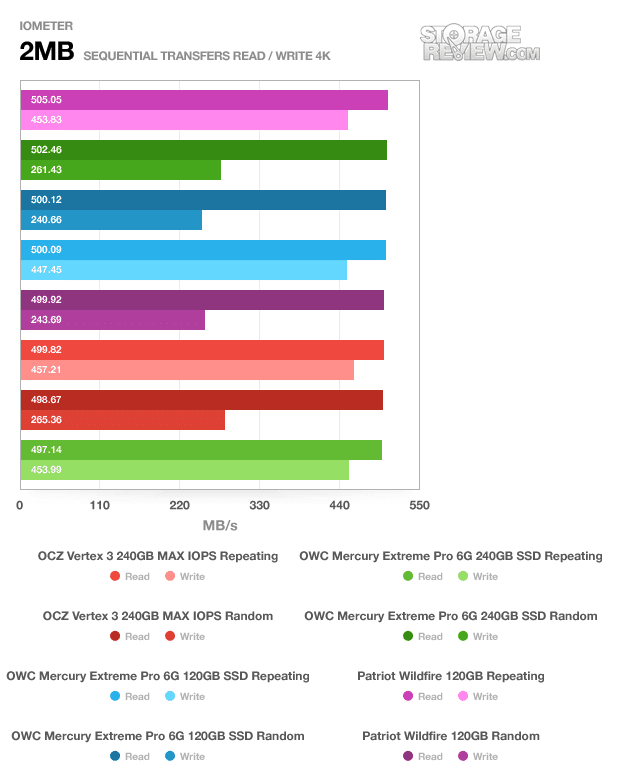
The OWC Mercury Extreme Pro offered similar transfer speeds to the OCZ and Patriot competition, with maximum read speeds varying between 497-500MB/s and write speeds between 240-453MB/s. With double the available flash pieces, the 240GB version of the ME Pro 6G came in 21MB/s faster than the smaller 120GB model.
Our next IOMeter test switches sequential for random 2MB transfers, which for most SSDs won’t have a huge impact give the solid-state design with no moving parts to lag behind.
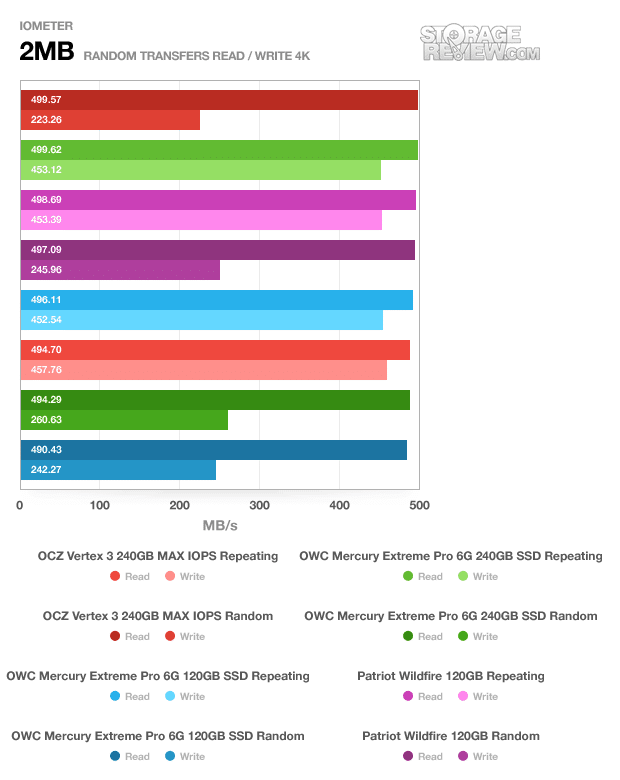
In this test the 240GB Mercury Extreme Pro 6G came out both on top in read speed and write speed over the smaller 120GB model. The biggest difference came down to incompressible write speeds, where 18MB/s separated them.
When it comes to SSDs, one of the biggest advertising points today is their random 4K read and write performance right up alongside their sequential read and write speeds. Compared to hard drives, SSDs don’t have any of the constraints of spinning physical media, where random access requires physical movement to change positions. This allows SSDs to reach much higher speeds while barely breaking a sweat. We take a look at speeds reached at a queue depth of one, as well as a queue depth up to 128 in later tests.
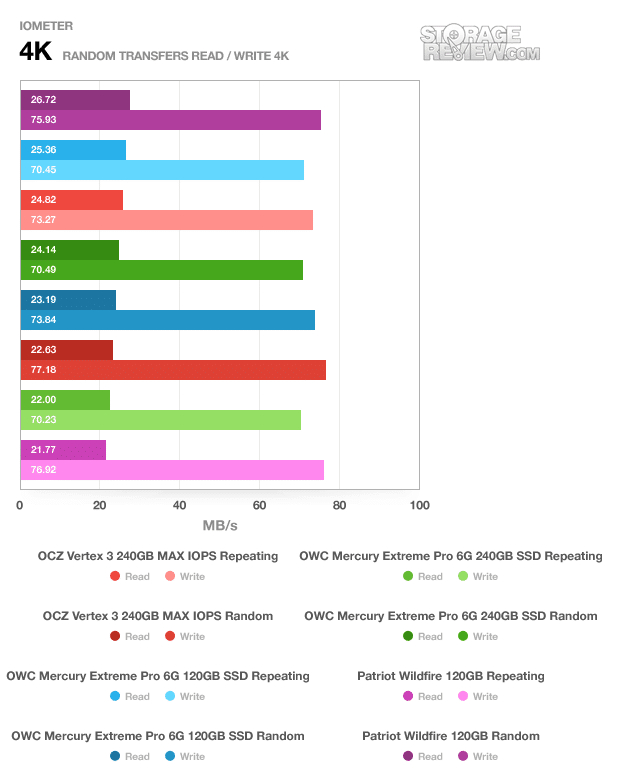
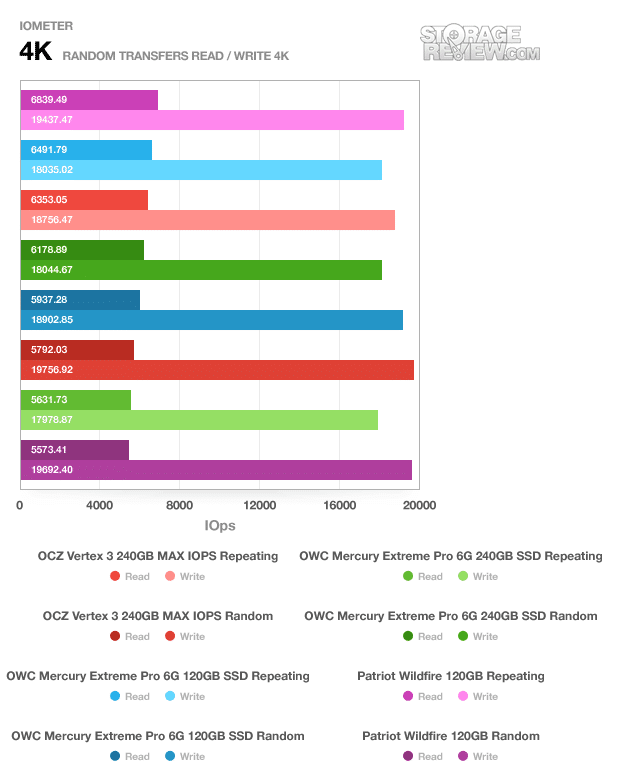
In the single queue depth random 4K transfer test, the 120GB Mercury Extreme Pro came in 2nd with repeating data in terms of read speed with nearly 6,500 IOps and a write speed of 18,000 IOps. In this area the 240GB model slipped behind, but as you can see below it won the prolonged fight in the higher queue depths.
While the first section just looked at random 4K read and write speeds at a queue depth at one, our next section covers 1 through 128 in 30 second intervals with no cooling down period.
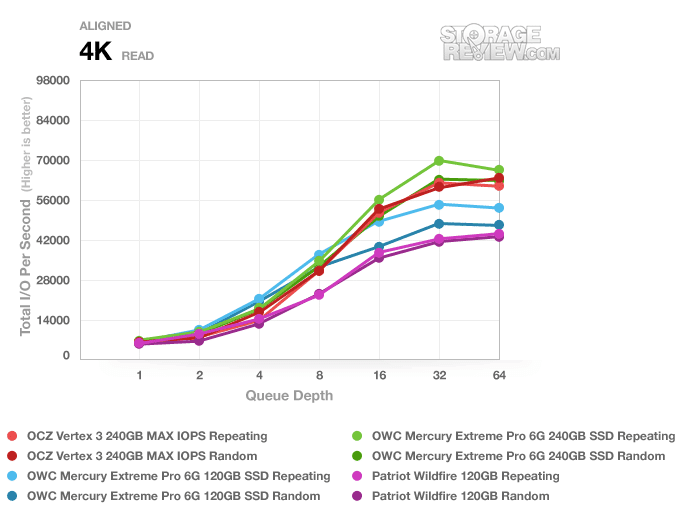
There was no doubt that having eight additional flash chips helped out the 240GB ME Pro 6G. The 240GB SSD had roughly a 15K IOps lead with repeating and random data.
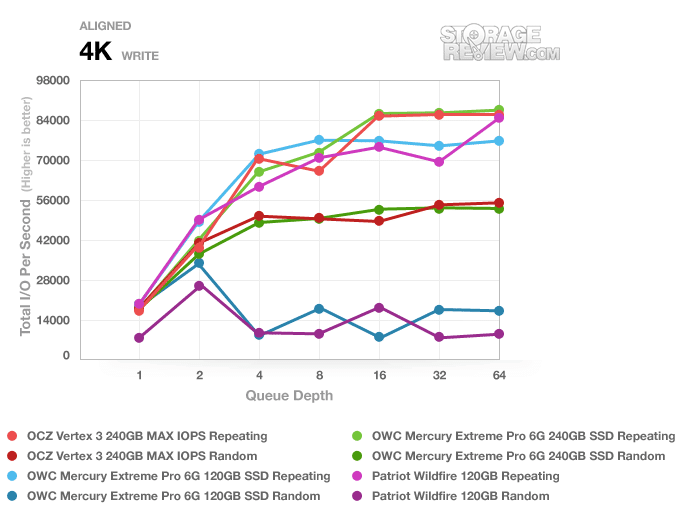
With the 4K write test the difference was night and day between the two capacities. The 240GB Mercury Extreme Pro 6G topped 89,000 IOps on our chart, 3,500 IOps above the OCZ Vertex 3 MAX IOPS. This was in stark contrast to the 120GB model that peaked at 35,000 IOps with random data before leveling off around 16,000 IOps, whereas the 240GB model stayed at 54,500 IOps.
The 240GB OWC Mercury Extreme Pro 6G came in under the 120GB model in our 4K write latency test. With an average response time of 0.055ms on the 240GB 6G versus 0.052-0.053ms of the 120GB, the trend appeared to be that the eight chip models had faster overall access times, which was confirmed by looking at the max response times of the various like-configuration models.
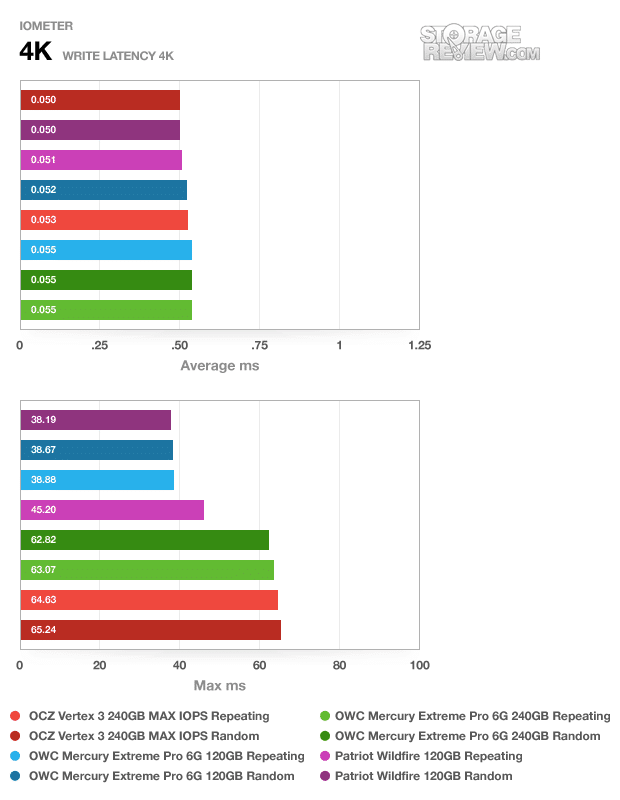
CrystalDiskMark showed very similar performance to IOMeter using random or incompressible data. Both drives offered roughly the same read speeds, but write speeds ended up being much greater on the 240GB ME Pro 6G.
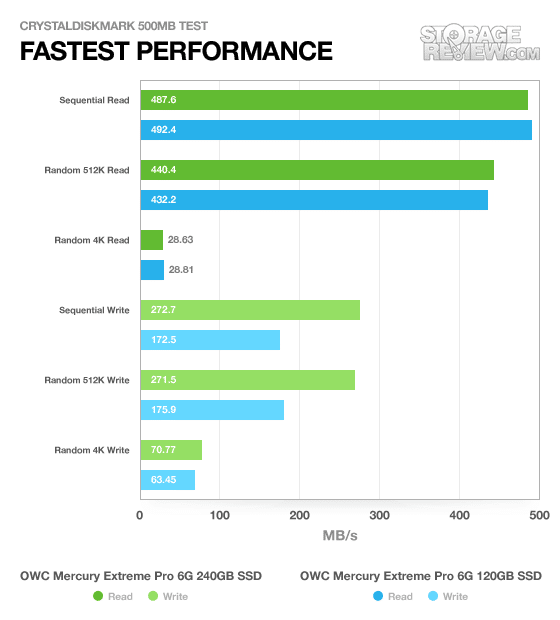
The last stage of our synthetic benchmarks covers IOMeter server profile tests. Performed in similar fashion to our ramped 4K read and write tests, these server profile benchmarks are a great way to see how well each SSD copes with continuous read/write loads. Each test lasts for a total of 8 minutes, with no resting period in-between each ramp in queue depth.
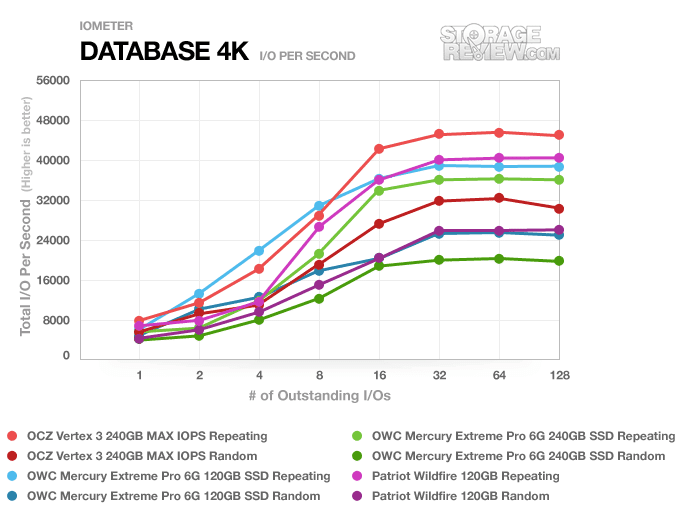
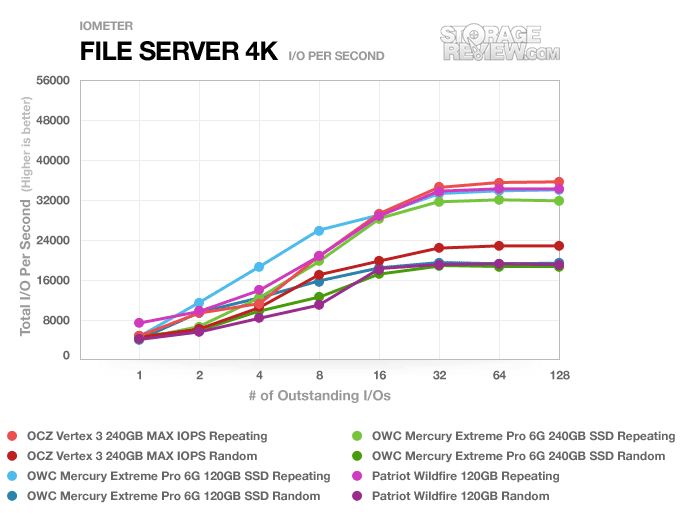
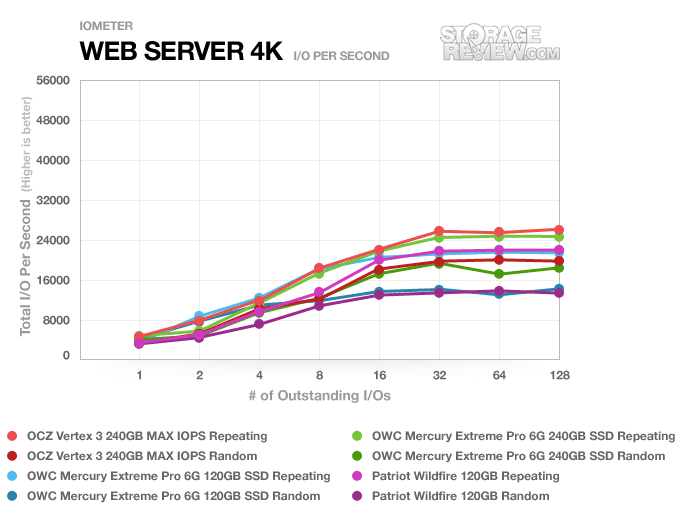
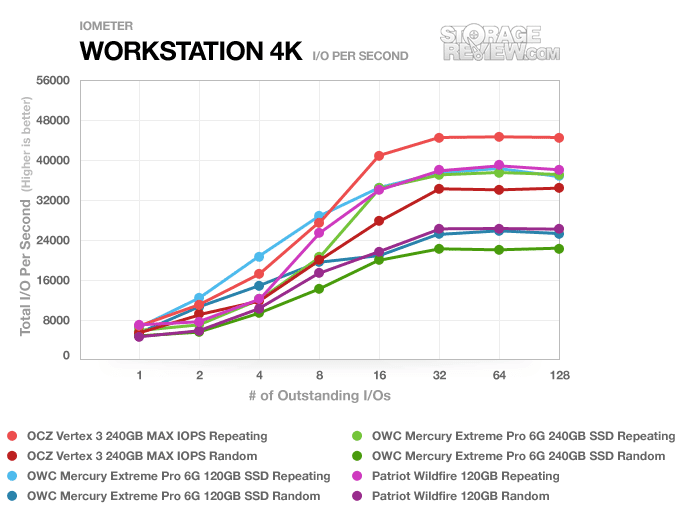
Real-World Benchmarks
If you are new to StorageReview, one thing we try to focus on is how any given drive might perform under real-world conditions. For the average user, trying to translate high random 4K write speeds into an everyday situation is pretty difficult. It also doesn’t make sense to assume that a drive with very high sequential speeds is going to perform great in the real-world if it can’t cope with mixed random activity. To really see how drives perform under normal work-loads you need to record the exact traffic being passed to and from the device, and then use that to compare drives against one another. For this reason we turned to our StorageMark 2010 traces, which include HTPC, Productivity, and Gaming scenarios to help our readers find out how well a drive might perform under their conditions.
As with our synthetic benchmarks, we put both OWC Mercury Extreme Pro 6G SSDs head to head alongside the 240GB Vertex 3 MAX IOPS and 120GB Patriot Wildfire. Given their very similar hardware configuration it would be a very apples to apples test outside of firmware differences.
The first real-life test is our HTPC scenario. In this test we include: playing one 720P HD movie in Media Player Classic, one 480P SD movie playing in VLC, three movies downloading simultaneously through iTunes, and one 1080i HDTV stream being recorded through Windows Media Center over a 15 minute period. Higher IOps and MB/s rates with lower latency times are preferred. In this trace we recorded 2,986MB being written to the drive and 1,924MB being read.
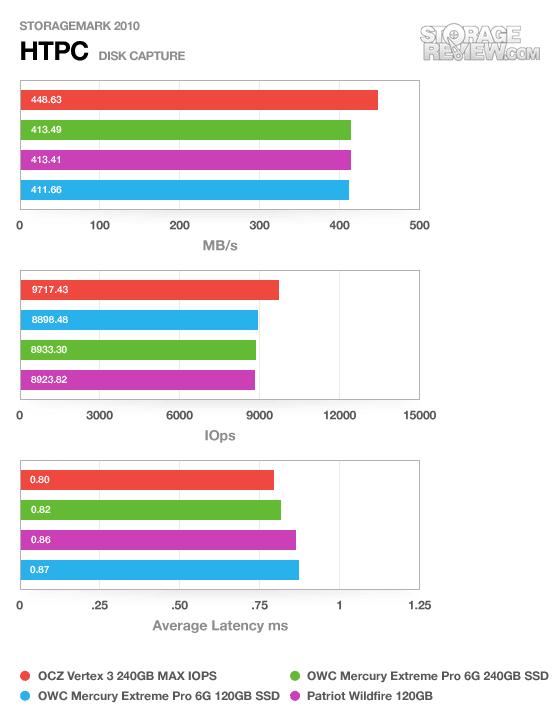
The increased NAND chip amount on the 240GB OWC Mercury Extreme Pro 6G didn’t put it way ahead the 120GB model in our HTPC trace. It had a lead of 2MB/s and averaged 0.05ms faster in latency.
Our second real-life test covers disk activity in a productivity scenario. For all intents and purposes this test shows drive performance under normal daily activity for most users. This test includes: a three hour period operating in an office productivity environment with 32-bit Vista running Outlook 2007 connected to an Exchange server, web browsing using Chrome and IE8, editing files within Office 2007, viewing PDFs in Adobe Reader, and an hour of local music playback with two hours of additional online music via Pandora. In this trace we recorded 4,830MB being written to the drive and 2,758MB being read.
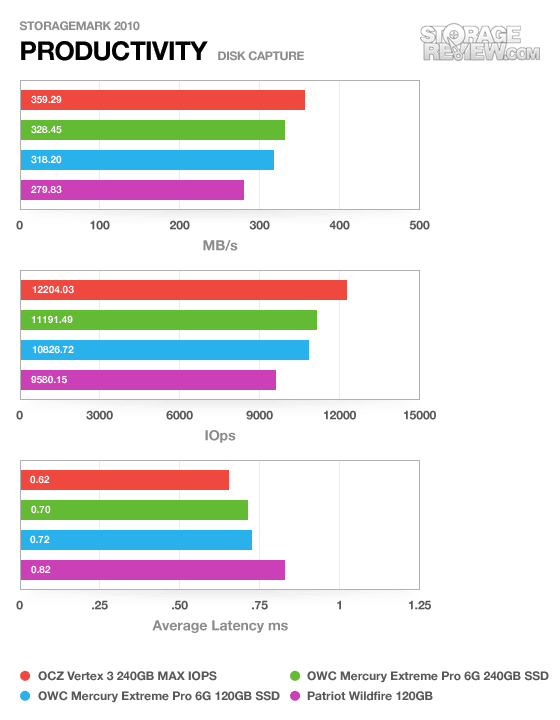
The spread between the 240GB and 120GB models increased in our Productivity trace, with a 10MB/s difference in average transfer speed and a 0.02ms better response time.
Our third real-life test covers disk activity in a gaming environment. Unlike the HTPC or Productivity trace, this one relies heavily on the read performance of a drive. To give a simple breakdown of read/write percentages, the HTPC test is 64% write, 36% read, the Productivity test is 59% write and 41% read, while the gaming trace is 6% write and 94% read. The test consists of a Windows 7 Ultimate 64-bit system pre-configured with Steam, with Grand Theft Auto 4, Left 4 Dead 2, and Mass Effect 2 already downloaded and installed. The trace captures the heavy read activity of each game loading from the start, as well as textures as the game progresses. In this trace we recorded 426MB being written to the drive and 7,235MB being read.
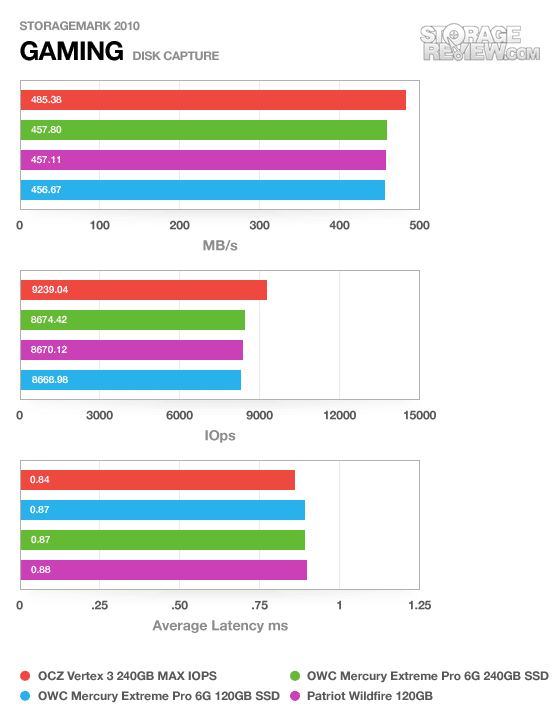
In the third and final trace both SSDs finished neck and neck with barely 10 IOps separating them. This wasn’t a huge surprise given the gaming trace was predominantly read-based and the main differences between each drive come out in heavy write tests.
Power Consumption
To measure the power consumption of the two OWC Mercury Extreme Pro 6G SSDs, we put them through the same IOMeter tests that we performed at the start of this review, and measured the power used in serial with the drives. We included both repeating and compressible write figures, since SandForce-based SSDs have to perform much less work when writing a compressible pattern to the drives.
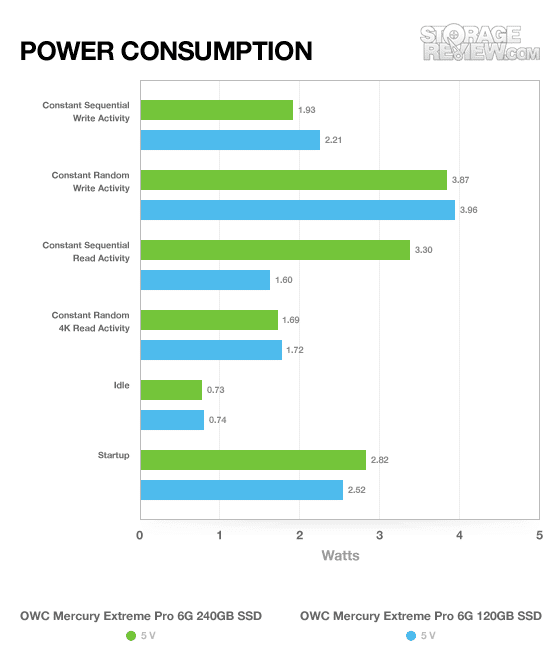
There wasn’t a huge difference in power consumption values between each capacity drive outside of a large spike in sequential read activity on the 240GB SSD. Both drives offered nearly the same idle power values, with closely matched compressible and incompressible sequential write values.
Warranty
OWC offers the industry’s longest warranty on the Mercury Extreme Pro 6G SSD, spanning five years instead of the usual three. This length is only matched by Intel on their SSD 320-series drives, which feature 25nm NAND. What makes this warranty unique now is this marks the first drive with Toshiba toggle NAND to sport five years, whereas before it was 25nm IMFT.
Conclusion
The change in NAND on the new OWC Mercury Extreme Pro 6G is an interesting shift, since for the same cost, consumers are now getting a higher performining drive. For the most part, this type of change bucks the common trends, which usually push to bring costs down during production, instead of improving performance or perhaps increasing internal costs. Another huge plus is OWC is keeping the same industry-leading five-year warranty on the Mercury Extreme Pro 6G, matched only by Intel, although OWC is the first to offer five-years with Toshiba toggle NAND.
Overall the updated ME Pro 6G offers everything we loved initially, and now it goes above and beyond.
Pros
- Boost in speed over synchronous NAND
- Same great five-year warranty
Cons
- Some compressible write speed differences between capacities
Bottom Line
The newly updated OWC Mercury Extreme Pro 6G offers faster speeds thanks to new Toshiba toggle NAND, with no increase in cost to the buyer while still keeping the great five-year warranty.




 Amazon
Amazon